2019 MERCEDES-BENZ GLA brake sensor
[x] Cancel search: brake sensorPage 9 of 346
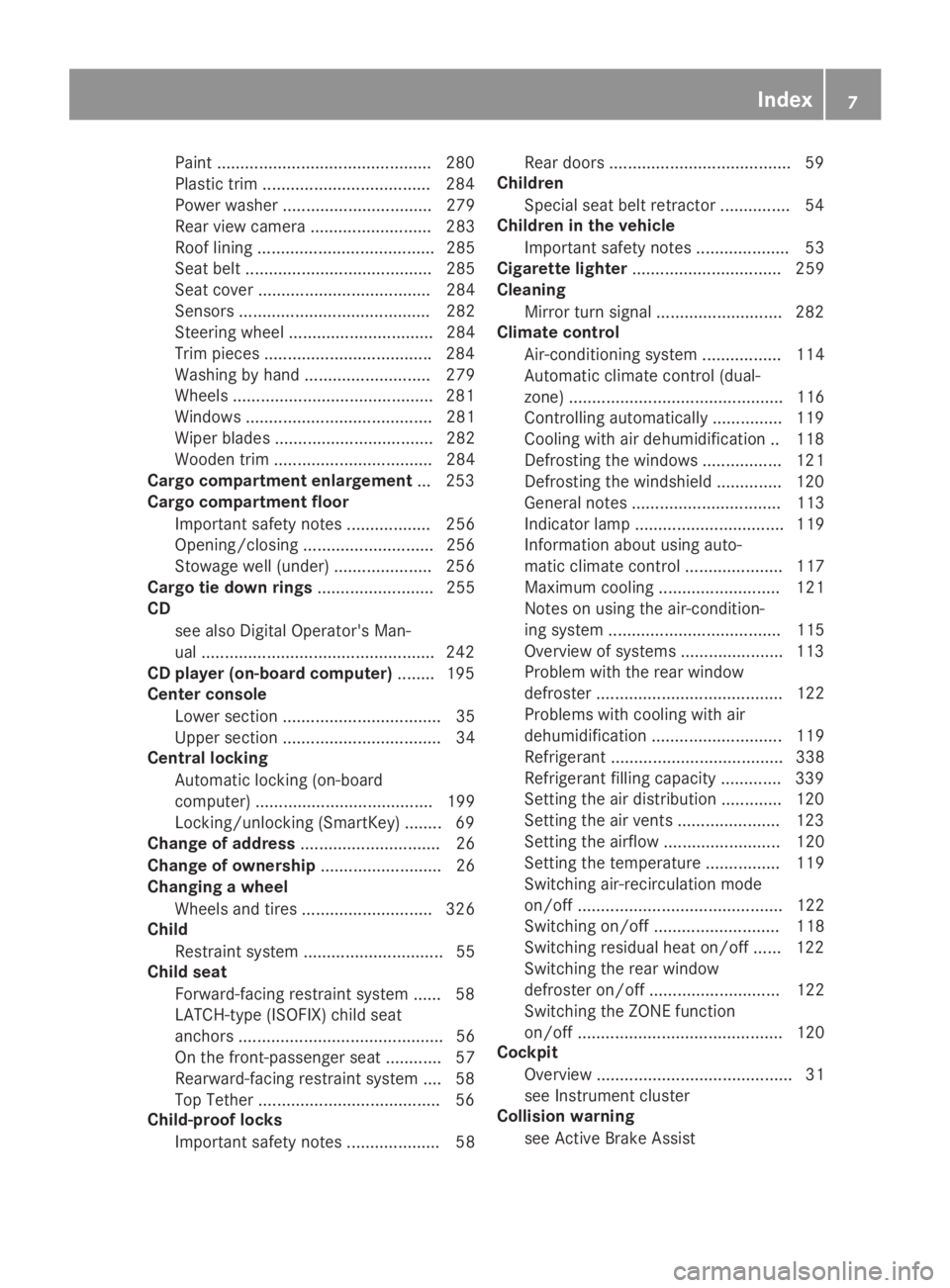
Paint ..............................................280
Plastic trim ....................................284
Power washer ................................ 279
Rear view camera .......................... 283
Roof lining ...................................... 285
Seat belt ........................................ 285
Seat cover ..................................... 284
Sensors ......................................... 282
Steering wheel ............................... 284
Trim pieces ....................................284
Washing by hand ........................... 279
Wheels ...........................................281
Windows ........................................ 281
Wiper blades .................................. 282
Wooden trim .................................. 284
Cargo compartment enlargement... 253
Cargo compartment floor
Important safety notes .................. 256
Opening/closing ............................ 256
Stowage well (under) ..................... 256
Cargo tie down rings......................... 255
CD
see also Digital Operator's Man-
ual ..................................................242
CD player (on-board computer)........195
Center console
Lower section .................................. 35
Upper section .................................. 34
Central locking
Automatic locking (on-board
computer) ...................................... 199
Locking/unlocking (SmartKey) ........69
Change of address.............................. 26
Change of ownership.......................... 26
Changing a wheel
Wheels and tires ............................ 326
Child
Restraint system .............................. 55
Child seat
Forward-facing restraint system ...... 58
LATCH-type (ISOFIX) child seat
anchors ............................................ 56
On the front-passenger seat ............ 57
Rearward-facing restraint system .... 58
Top Tether .......................................56
Child-proof locks
Important safety notes .................... 58
Rear doors .......................................59
Children
Special seat belt retractor ...............54
Children in the vehicle
Important safety notes .................... 53
Cigarette lighter................................ 259
Cleaning
Mirror turn signal ...........................282
Climate control
Air-conditioning system ................. 114
Automatic climate control (dual-
zone) .............................................. 116
Controlling automatically ...............119
Cooling with air dehumidification .. 118
Defrosting the windows ................. 121
Defrosting the windshield .............. 120
General notes ................................ 113
Indicator lamp ................................ 119
Information about using auto-
matic climate control ..................... 117
Maximum cooling .......................... 121
Notes on using the air-condition-
ing system ..................................... 115
Overview of systems ......................113
Problem with the rear window
defroster ........................................ 122
Problems with cooling with air
dehumidification ............................ 119
Refrigerant ..................................... 338
Refrigerant filling capacity ............. 339
Setting the air distribution ............. 120
Setting the air vents ......................123
Setting the airflow ......................... 120
Setting the temperature ................ 119
Switching air-recirculation mode
on/off ............................................ 122
Switching on/off ........................... 118
Switching residual heat on/off ...... 122
Switching the rear window
defroster on/off ............................ 122
Switching the ZONE function
on/off ............................................ 120
Cockpit
Overview .......................................... 31
see Instrument cluster
Collision warning
see Active Brake Assist
Index7
Page 17 of 346
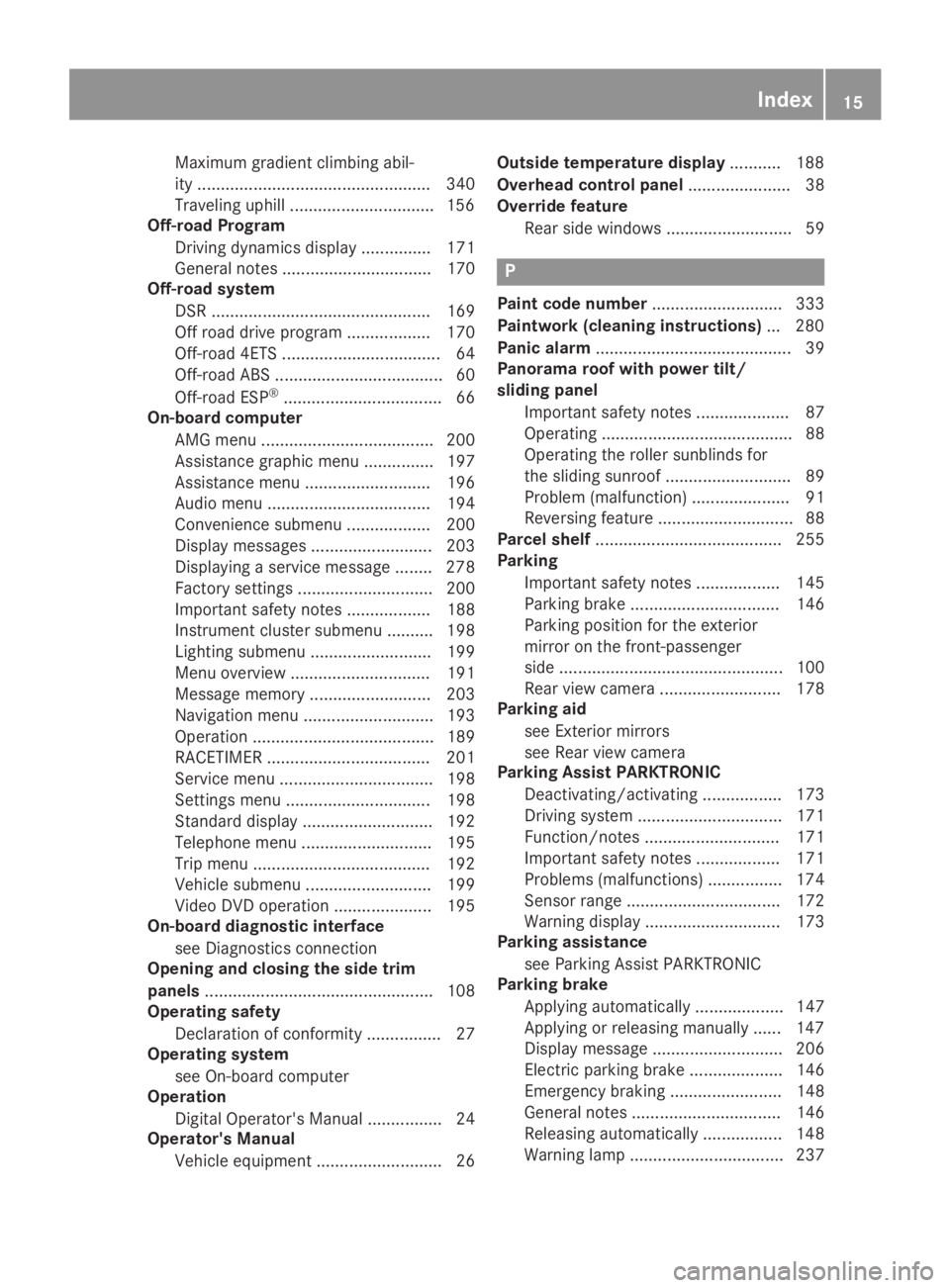
Maximum gradient climbing abil-
ity .................................................. 340
Traveling uphill ...............................156
Off-road Program
Driving dynamics display............... 171
General notes ................................ 170
Off-road system
DSR ............................................... 169
Off road drive program .................. 170
Off-road 4ETS .................................. 64
Off-road ABS .................................... 60
Off-road ESP®.................................. 66
On-board computer
AMG menu ..................................... 200
Assistance graphic menu ............... 197
Assistance menu ........................... 196
Audio menu ................................... 194
Convenience submenu .................. 200
Display messages .......................... 203
Displaying a service message ........ 278
Factory settings ............................. 200
Important safety notes .................. 188
Instrument cluster submenu .......... 198
Lighting submenu .......................... 199
Menu overview .............................. 191
Message memory .......................... 203
Navigation menu ............................ 193
Operation ....................................... 189
RACETIMER ................................... 201
Service menu ................................. 198
Settings menu ............................... 198
Standard display ............................ 192
Telephone menu ............................ 195
Trip menu ...................................... 192
Vehicle submenu ........................... 199
Video DVD operation ..................... 195
On-board diagnostic interface
see Diagnostics connection
Opening and closing the side trim
panels................................................. 108
Operating safety
Declaration of conformity ................ 27
Operating system
see On-board computer
Operation
Digital Operator's Manual................ 24
Operator's Manual
Vehicle equipment ........................... 26
Outside temperature display........... 188
Overhead control panel...................... 38
Override feature
Rear side windows........................... 59
P
Paint code number............................ 333
Paintwork (cleaning instructions)... 280
Panic alarm.......................................... 39
Panorama roof with power tilt/
sliding panel
Important safety notes .................... 87
Operating ......................................... 88
Operating the roller sunblinds for
the sliding sunroof ........................... 89
Problem (malfunction) ..................... 91
Reversing feature ............................. 88
Parcel shelf........................................ 255
Parking
Important safety notes .................. 145
Parking brake ................................ 146
Parking position for the exterior
mirror on the front-passenger
side ................................................ 100
Rear view camera .......................... 178
Parking aid
see Exterior mirrors
see Rear view camera
Parking Assist PARKTRONIC
Deactivating/activating ................. 173
Driving system ............................... 171
Function/notes............................. 171
Important safety notes .................. 171
Problems (malfunctions) ................ 174
Sensor range ................................. 172
Warning display ............................. 173
Parking assistance
see Parking Assist PARKTRONIC
Parking brake
Applying automatically................... 147
Applying or releasing manually ...... 147
Display message ............................ 206
Electric parking brake .................... 146
Emergency braking ........................ 148
General notes ................................ 146
Releasing automatically................. 148
Warning lamp ................................. 237
Index15
Page 20 of 346
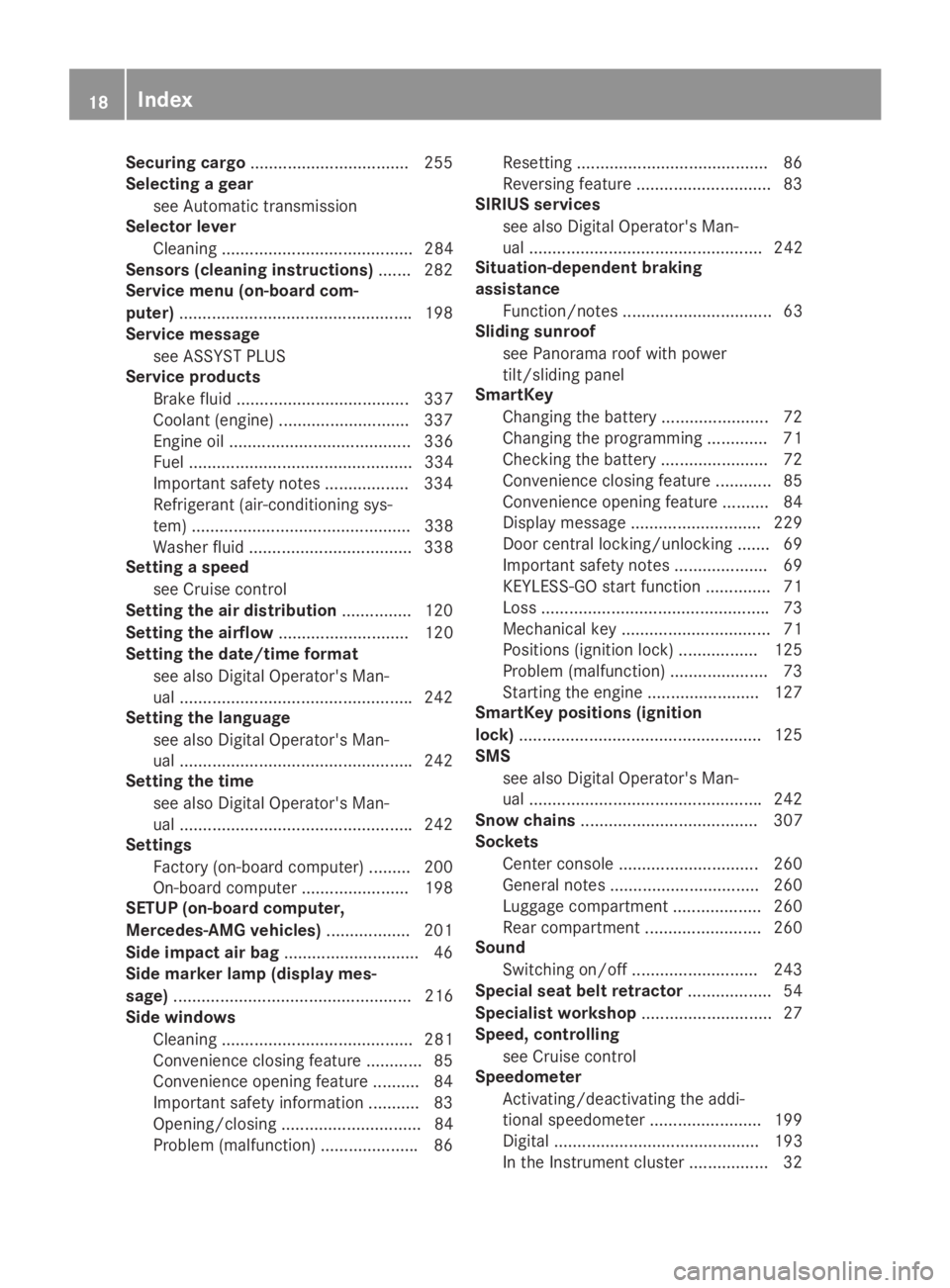
Securing cargo..................................255
Selecting a gear
see Automatic transmission
Selector lever
Cleaning ......................................... 284
Sensors (cleaning instructions)....... 282
Service menu (on-board com-
puter)..................................................198
Service message
see ASSYST PLUS
Service products
Brake fluid ..................................... 337
Coolant (engine) ............................ 337
Engine oil ....................................... 336
Fuel ................................................ 334
Important safety notes .................. 334
Refrigerant (air-conditioning sys-
tem) ............................................... 338
Washer fluid ................................... 338
Setting a speed
see Cruise control
Setting the air distribution...............120
Setting the airflow............................ 120
Setting the date/time format
see also Digital Operator's Man-
ual ..................................................242
Setting the language
see also Digital Operator's Man-
ual ..................................................242
Setting the time
see also Digital Operator's Man-
ual ..................................................242
Settings
Factory (on-board computer) ......... 200
On-board computer ....................... 198
SETUP (on-board computer,
Mercedes-AMG vehicles).................. 201
Side impact air bag.............................46
Side marker lamp (display mes-
sage)................................................... 216
Side windows
Cleaning ......................................... 281
Convenience closing feature ............ 85
Convenience opening feature ..........84
Important safety information ........... 83
Opening/closing .............................. 84
Problem (malfunction) .....................86
Resetting .........................................86
Reversing feature .............................83
SIRIUS services
see also Digital Operator's Man-
ual .................................................. 242
Situation-dependent braking
assistance
Function/notes ................................ 63
Sliding sunroof
see Panorama roof with power
tilt/sliding panel
SmartKey
Changing the battery ....................... 72
Changing the programming .............71
Checking the battery .......................72
Convenience closing feature ............ 85
Convenience opening feature .......... 84
Display message ............................ 229
Door central locking/unlocking .......69
Important safety notes .................... 69
KEYLESS-GO start function .............. 71
Loss .................................................73
Mechanical key ................................ 71
Positions (ignition lock) ................. 125
Problem (malfunction) ..................... 73
Starting the engine ........................ 127
SmartKey positions (ignition
lock)....................................................125
SMS
see also Digital Operator's Man-
ual ..................................................242
Snow chains...................................... 307
Sockets
Center console .............................. 260
General notes ................................ 260
Luggage compartment ................... 260
Rear compartment ......................... 260
Sound
Switching on/off ........................... 243
Special seat belt retractor.................. 54
Specialist workshop............................ 27
Speed, controlling
see Cruise control
Speedometer
Activating/deactivating the addi-
tional speedometer ........................ 199
Digital ............................................ 193
In the Instrument cluster ................. 32
18Index
Page 63 of 346
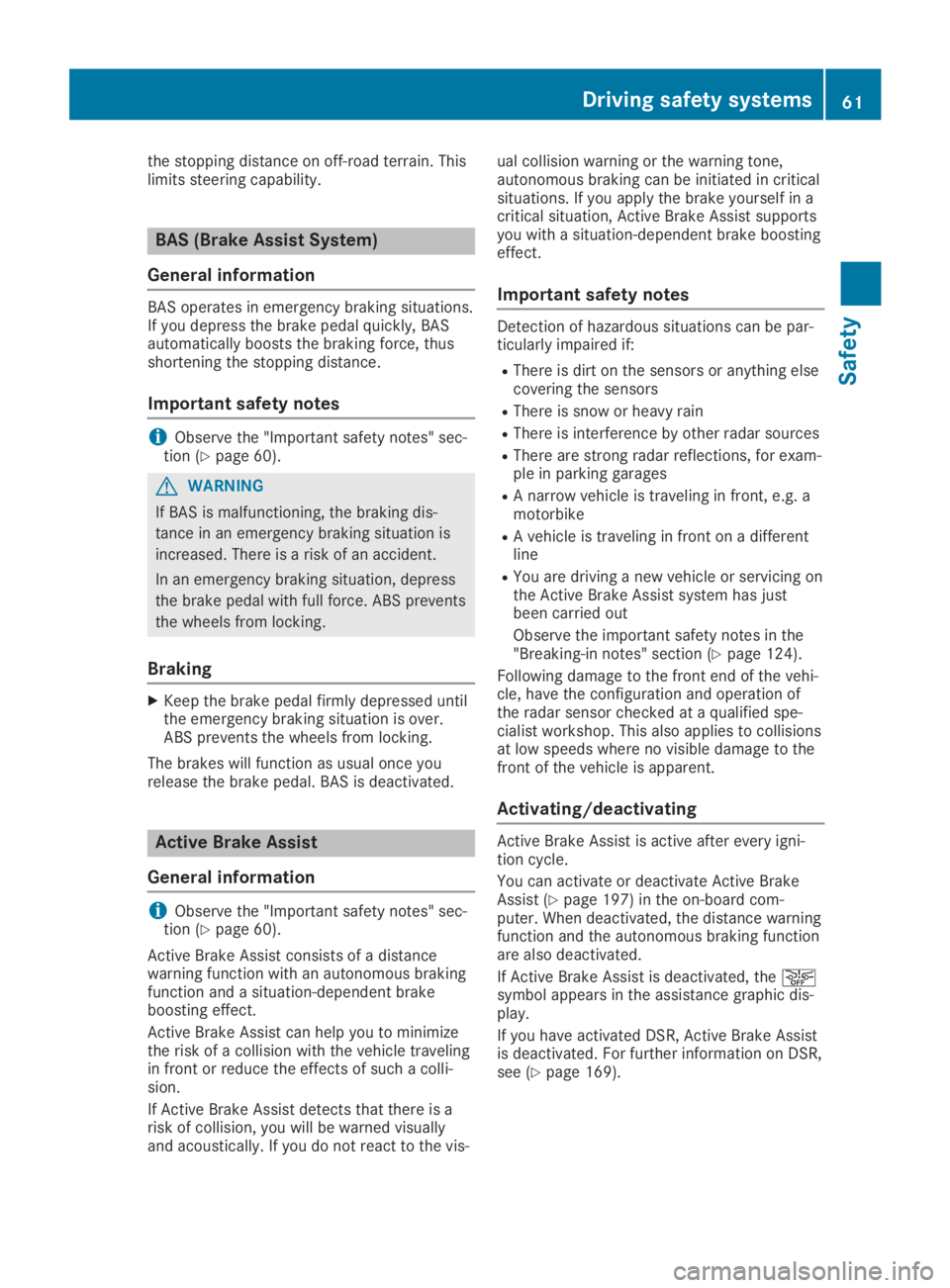
the stopping distance on off-road terrain. Thislimits steering capability.
BAS (Brake Assist System)
General information
BAS operates in emergency braking situations.If you depress the brake pedal quickly, BASautomatically boosts the braking force, thusshortening the stopping distance.
Important safety notes
iObserve the "Important safety notes" sec-tion (Ypage 60).
GWARNING
If BAS is malfunctioning, the braking dis-
tance in an emergency braking situation is
increased. There is a risk of an accident.
In an emergency braking situation, depress
the brake pedal with full force. ABS prevents
the wheels from locking.
Braking
XKeep the brake pedal firmly depressed untilthe emergency braking situation is over.ABS prevents the wheels from locking.
The brakes will function as usual once yourelease the brake pedal. BAS is deactivated.
Active Brake Assist
General information
iObserve the "Important safety notes" sec-tion (Ypage 60).
Active Brake Assist consists of a distancewarning function with an autonomous brakingfunction and a situation-dependent brakeboosting effect.
Active Brake Assist can help you to minimizethe risk of a collision with the vehicle travelingin front or reduce the effects of such a colli-sion.
If Active Brake Assist detects that there is arisk of collision, you will be warned visuallyand acoustically. If you do not react to the vis-
ual collision warning or the warning tone,autonomous braking can be initiated in criticalsituations. If you apply the brake yourself in acritical situation, Active Brake Assist supportsyou with a situation-dependent brake boostingeffect.
Important safety notes
Detection of hazardous situations can be par-ticularly impaired if:
RThere is dirt on the sensors or anything elsecovering the sensors
RThere is snow or heavy rain
RThere is interference by other radar sources
RThere are strong radar reflections, for exam-ple in parking garages
RA narrow vehicle is traveling in front, e.g. amotorbike
RA vehicle is traveling in front on a differentline
RYou are driving a new vehicle or servicing onthe Active Brake Assist system has justbeen carried out
Observe the important safety notes in the"Breaking-in notes" section (Ypage 124).
Following damage to the front end of the vehi-cle, have the configuration and operation ofthe radar sensor checked at a qualified spe-cialist workshop. This also applies to collisionsat low speeds where no visible damage to thefront of the vehicle is apparent.
Activating/deactivating
Active Brake Assist is active after every igni-tion cycle.
You can activate or deactivate Active BrakeAssist (Ypage 197) in the on-board com-puter. When deactivated, the distance warningfunction and the autonomous braking functionare also deactivated.
If Active Brake Assist is deactivated, the�
Page 65 of 346
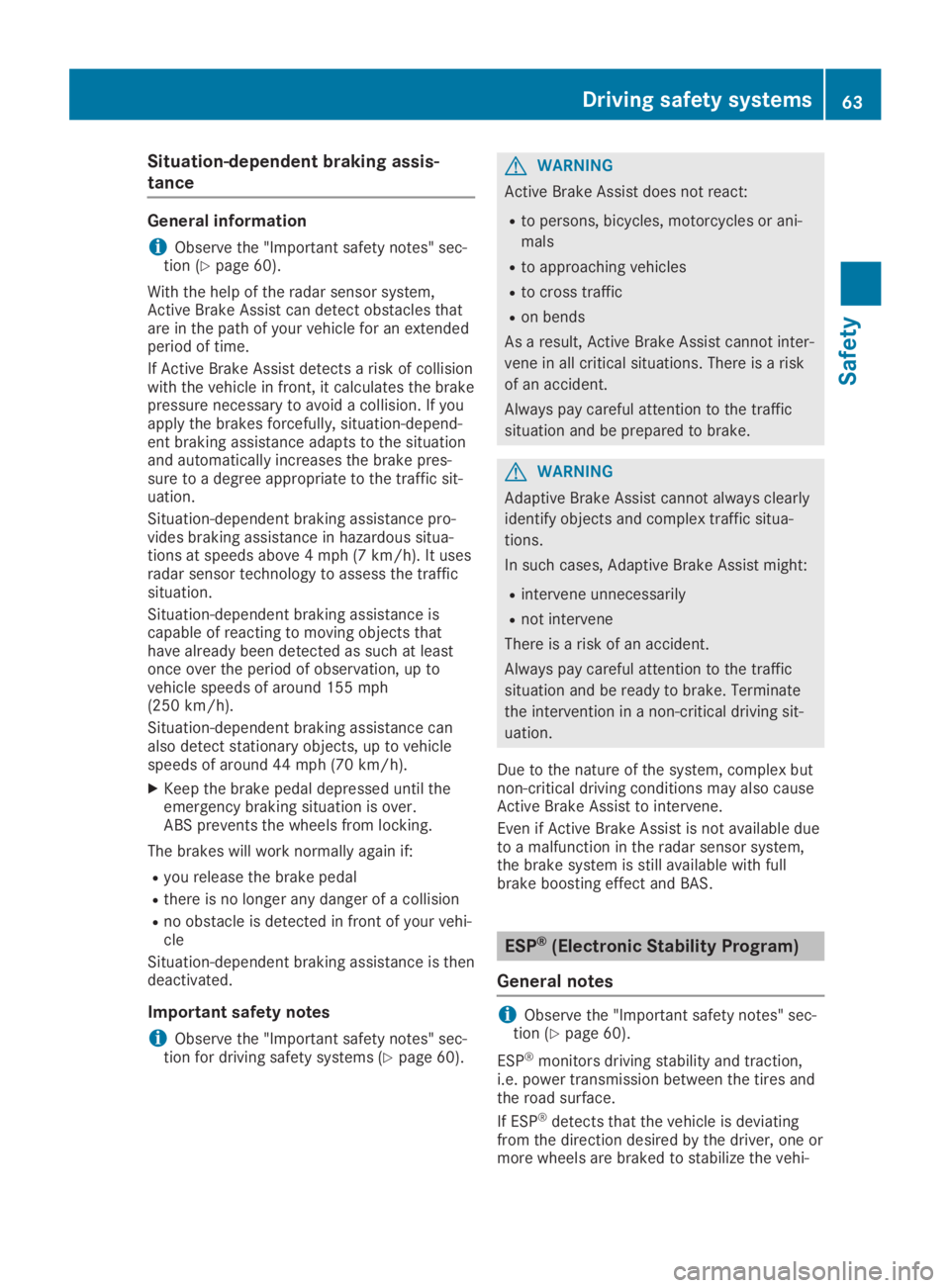
Situation-dependent braking assis-
tance
General information
iObserve the "Important safety notes" sec-tion (Ypage 60).
With the help of the radar sensor system,Active Brake Assist can detect obstacles thatare in the path of your vehicle for an extendedperiod of time.
If Active Brake Assist detects a risk of collisionwith the vehicle in front, it calculates the brakepressure necessary to avoid a collision. If youapply the brakes forcefully, situation-depend-ent braking assistance adapts to the situationand automatically increases the brake pres-sure to a degree appropriate to the traffic sit-uation.
Situation-dependent braking assistance pro-vides braking assistance in hazardous situa-tions at speeds above 4 mph (7 km/h). It usesradar sensor technology to assess the trafficsituation.
Situation-dependent braking assistance iscapable of reacting to moving objects thathave already been detected as such at leastonce over the period of observation, up tovehicle speeds of around 155 mph(250 km/h).
Situation-dependent braking assistance canalso detect stationary objects, up to vehiclespeeds of around 44 mph (70 km/h).
XKeep the brake pedal depressed until theemergency braking situation is over.ABS prevents the wheels from locking.
The brakes will work normally again if:
Ryou release the brake pedal
Rthere is no longer any danger of a collision
Rno obstacle is detected in front of your vehi-cle
Situation-dependent braking assistance is thendeactivated.
Important safety notes
iObserve the "Important safety notes" sec-tion for driving safety systems (Ypage 60).
GWARNING
Active Brake Assist does not react:
Rto persons, bicycles, motorcycles or ani-
mals
Rto approaching vehicles
Rto cross traffic
Ron bends
As a result, Active Brake Assist cannot inter-
vene in all critical situations. There is a risk
of an accident.
Always pay careful attention to the traffic
situation and be prepared to brake.
GWARNING
Adaptive Brake Assist cannot always clearly
identify objects and complex traffic situa-
tions.
In such cases, Adaptive Brake Assist might:
Rintervene unnecessarily
Rnot intervene
There is a risk of an accident.
Always pay careful attention to the traffic
situation and be ready to brake. Terminate
the intervention in a non-critical driving sit-
uation.
Due to the nature of the system, complex butnon-critical driving conditions may also causeActive Brake Assist to intervene.
Even if Active Brake Assist is not available dueto a malfunction in the radar sensor system,the brake system is still available with fullbrake boosting effect and BAS.
ESP®(Electronic Stability Program)
General notes
iObserve the "Important safety notes" sec-tion (Ypage 60).
ESP®monitors driving stability and traction,i.e. power transmission between the tires andthe road surface.
If ESP®detects that the vehicle is deviatingfrom the direction desired by the driver, one ormore wheels are braked to stabilize the vehi-
Driving safety systems63
Safety
Z
Page 126 of 346
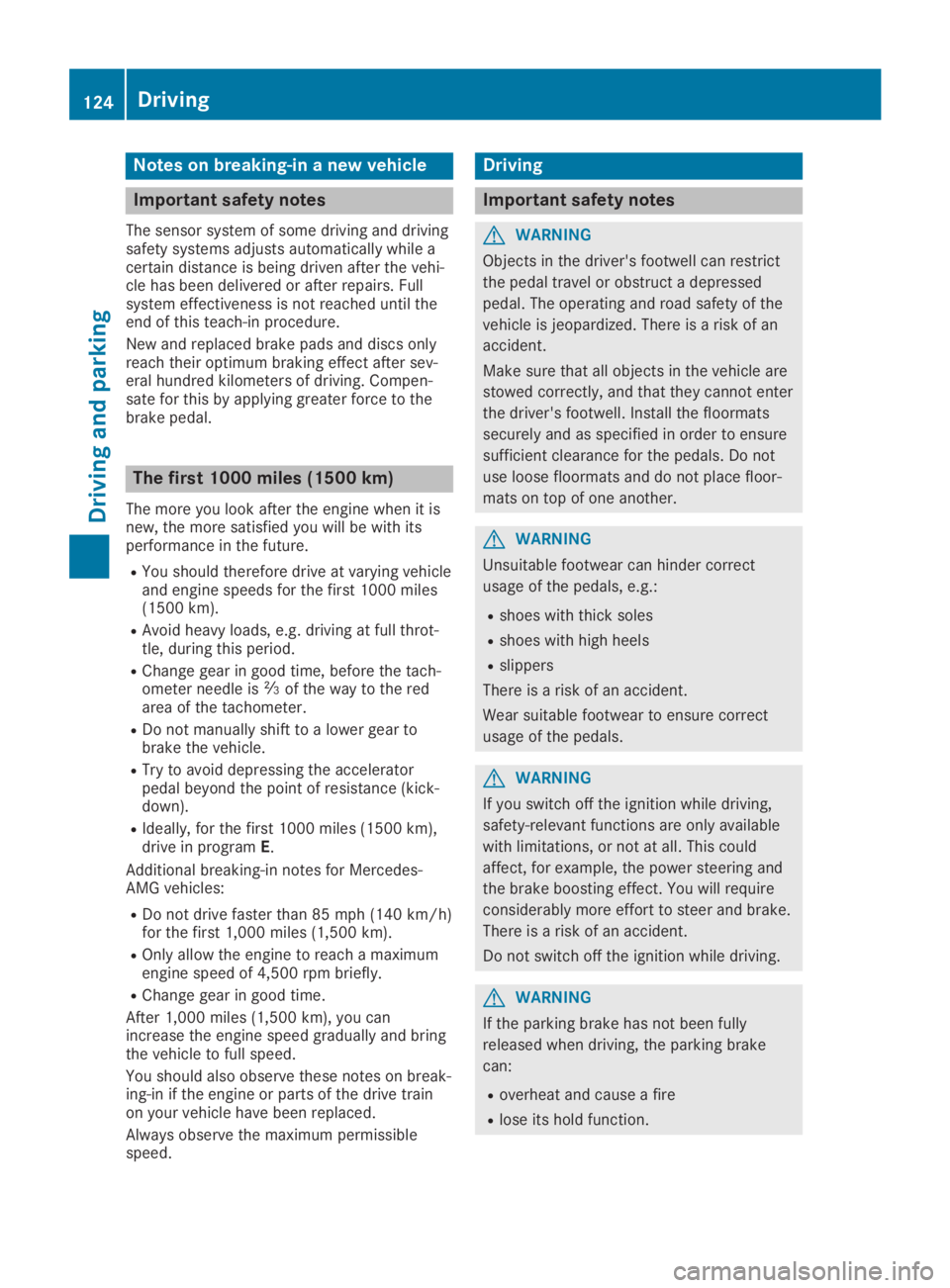
Notes on breaking-in a new vehicle
Important safety notes
The sensor system of some driving and drivingsafety systems adjusts automatically while acertain distance is being driven after the vehi-cle has been delivered or after repairs. Fullsystem effectiveness is not reached until theend of this teach-in procedure.
New and replaced brake pads and discs onlyreach their optimum braking effect after sev-eral hundred kilometers of driving. Compen-sate for this by applying greater force to thebrake pedal.
The first 1000 miles (1500 km)
The more you look after the engine when it isnew, the more satisfied you will be with itsperformance in the future.
RYou should therefore drive at varying vehicleand engine speeds for the first 1000 miles(1500 km).
RAvoid heavy loads, e.g. driving at full throt-tle, during this period.
RChange gear in good time, before the tach-ometer needle is�
Page 161 of 346
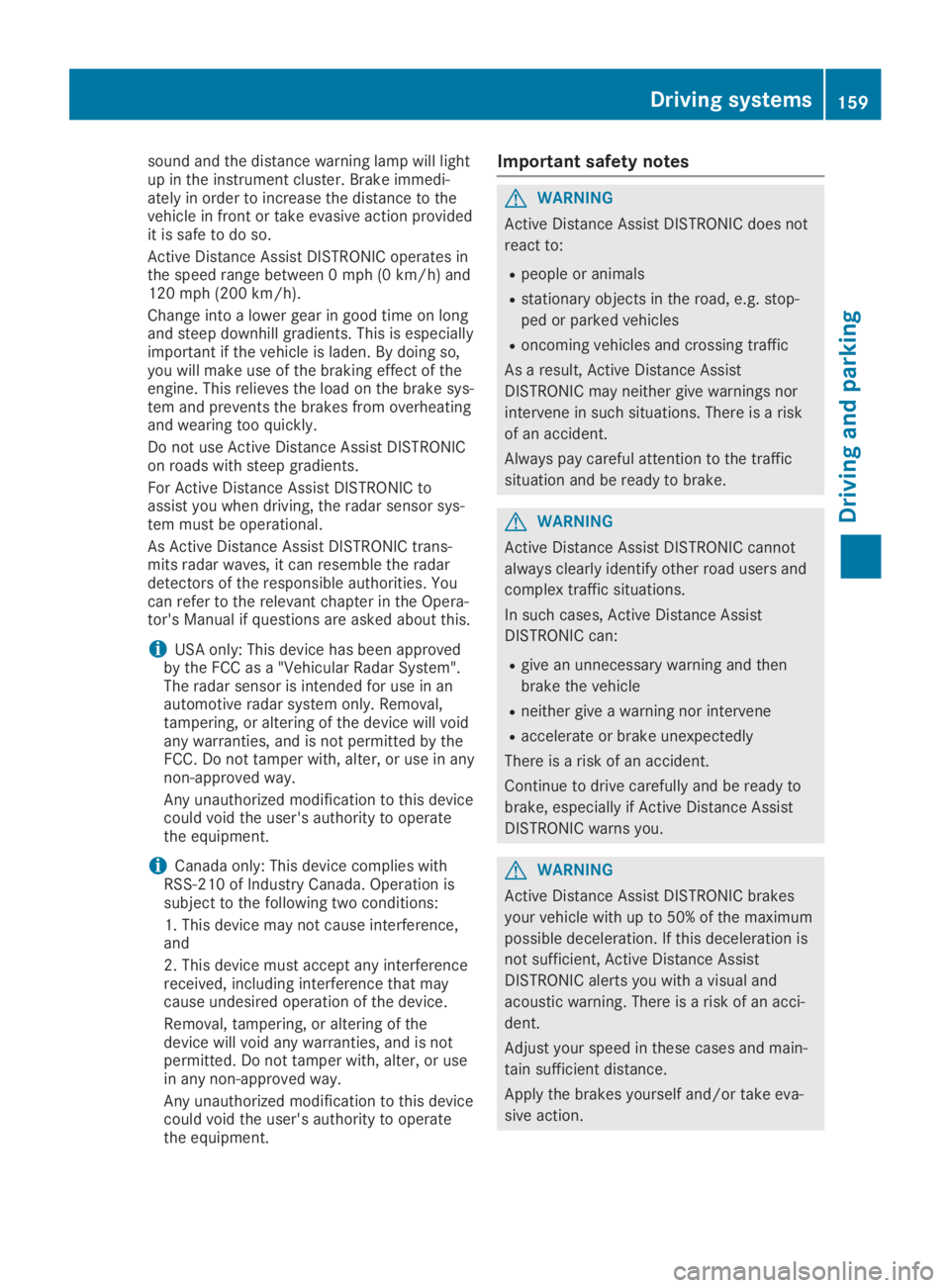
sound and the distance warning lamp will lightup in the instrument cluster. Brake immedi-ately in order to increase the distance to thevehicle in front or take evasive action providedit is safe to do so.
Active Distance Assist DISTRONIC operates inthe speed range between 0 mph (0 km/h) and120 mph (200 km/h).
Change into a lower gear in good time on longand steep downhill gradients. This is especiallyimportant if the vehicle is laden. By doing so,you will make use of the braking effect of theengine. This relieves the load on the brake sys-tem and prevents the brakes from overheatingand wearing too quickly.
Do not use Active Distance Assist DISTRONICon roads with steep gradients.
For Active Distance Assist DISTRONIC toassist you when driving, the radar sensor sys-tem must be operational.
As Active Distance Assist DISTRONIC trans-mits radar waves, it can resemble the radardetectors of the responsible authorities. Youcan refer to the relevant chapter in the Opera-tor's Manual if questions are asked about this.
iUSA only: This device has been approvedby the FCC as a "Vehicular Radar System".The radar sensor is intended for use in anautomotive radar system only. Removal,tampering, or altering of the device will voidany warranties, and is not permitted by theFCC. Do not tamper with, alter, or use in anynon-approved way.
Any unauthorized modification to this devicecould void the user's authority to operatethe equipment.
iCanada only: This device complies withRSS-210 of Industry Canada. Operation issubject to the following two conditions:
1. This device may not cause interference,and
2. This device must accept any interferencereceived, including interference that maycause undesired operation of the device.
Removal, tampering, or altering of thedevice will void any warranties, and is notpermitted. Do not tamper with, alter, or usein any non-approved way.
Any unauthorized modification to this devicecould void the user's authority to operatethe equipment.
Important safety notes
GWARNING
Active Distance Assist DISTRONIC does not
react to:
Rpeople or animals
Rstationary objects in the road, e.g. stop-
ped or parked vehicles
Roncoming vehicles and crossing traffic
As a result, Active Distance Assist
DISTRONIC may neither give warnings nor
intervene in such situations. There is a risk
of an accident.
Always pay careful attention to the traffic
situation and be ready to brake.
GWARNING
Active Distance Assist DISTRONIC cannot
always clearly identify other road users and
complex traffic situations.
In such cases, Active Distance Assist
DISTRONIC can:
Rgive an unnecessary warning and then
brake the vehicle
Rneither give a warning nor intervene
Raccelerate or brake unexpectedly
There is a risk of an accident.
Continue to drive carefully and be ready to
brake, especially if Active Distance Assist
DISTRONIC warns you.
GWARNING
Active Distance Assist DISTRONIC brakes
your vehicle with up to 50% of the maximum
possible deceleration. If this deceleration is
not sufficient, Active Distance Assist
DISTRONIC alerts you with a visual and
acoustic warning. There is a risk of an acci-
dent.
Adjust your speed in these cases and main-
tain sufficient distance.
Apply the brakes yourself and/or take eva-
sive action.
Driving systems159
Driving and parking
Z
Page 162 of 346
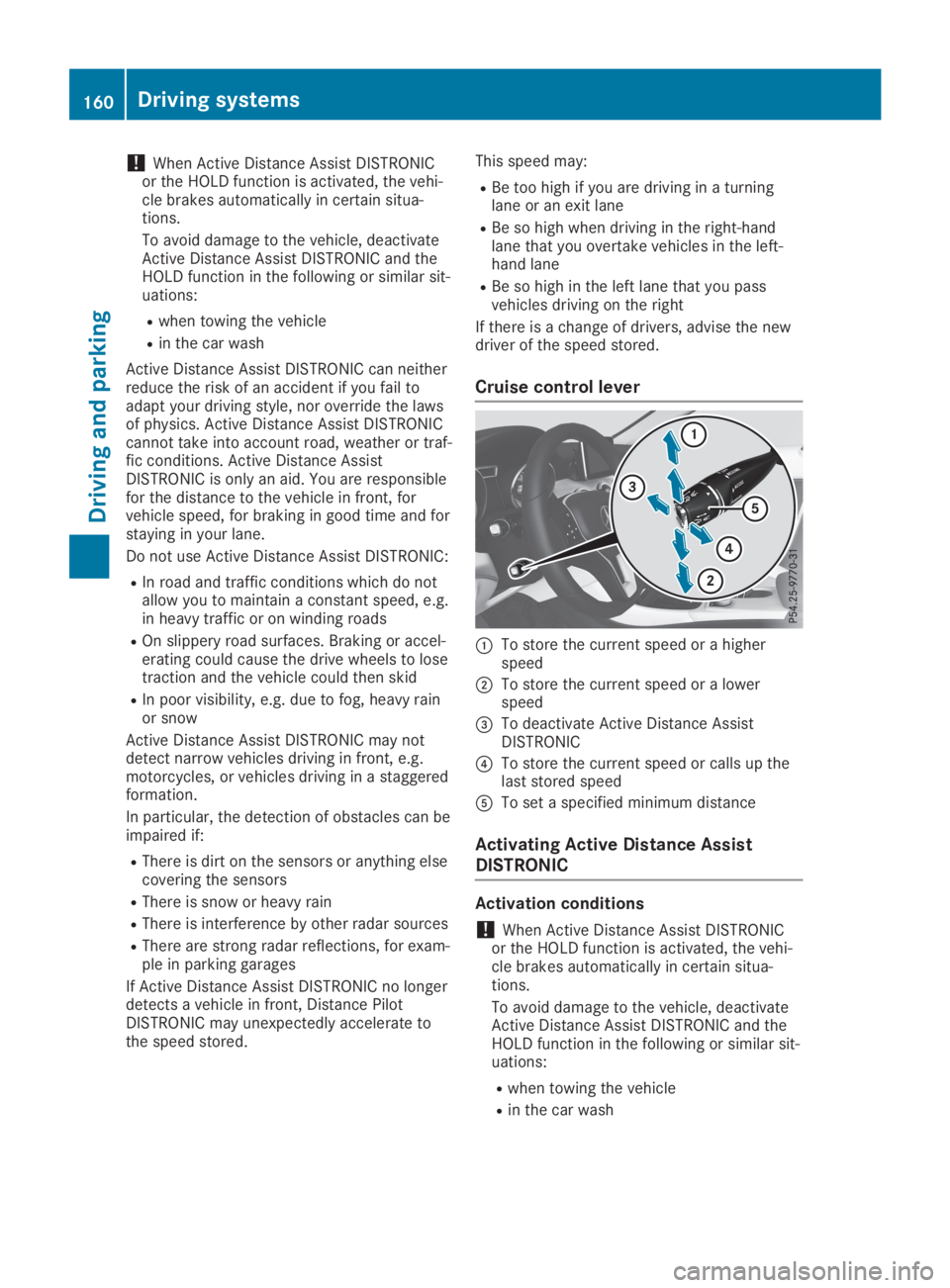
!When Active Distance Assist DISTRONICor the HOLD function is activated, the vehi-cle brakes automatically in certain situa-tions.
To avoid damage to the vehicle, deactivateActive Distance Assist DISTRONIC and theHOLD function in the following or similar sit-uations:
Rwhen towing the vehicle
Rin the car wash
Active Distance Assist DISTRONIC can neitherreduce the risk of an accident if you fail toadapt your driving style, nor override the lawsof physics. Active Distance Assist DISTRONICcannot take into account road, weather or traf-fic conditions. Active Distance AssistDISTRONIC is only an aid. You are responsiblefor the distance to the vehicle in front, forvehicle speed, for braking in good time and forstaying in your lane.
Do not use Active Distance Assist DISTRONIC:
RIn road and traffic conditions which do notallow you to maintain a constant speed, e.g.in heavy traffic or on winding roads
ROn slippery road surfaces. Braking or accel-erating could cause the drive wheels to losetraction and the vehicle could then skid
RIn poor visibility, e.g. due to fog, heavy rainor snow
Active Distance Assist DISTRONIC may notdetect narrow vehicles driving in front, e.g.motorcycles, or vehicles driving in a staggeredformation.
In particular, the detection of obstacles can beimpaired if:
RThere is dirt on the sensors or anything elsecovering the sensors
RThere is snow or heavy rain
RThere is interference by other radar sources
RThere are strong radar reflections, for exam-ple in parking garages
If Active Distance Assist DISTRONIC no longerdetects a vehicle in front, Distance PilotDISTRONIC may unexpectedly accelerate tothe speed stored.
This speed may:
RBe too high if you are driving in a turninglane or an exit lane
RBe so high when driving in the right-handlane that you overtake vehicles in the left-hand lane
RBe so high in the left lane that you passvehicles driving on the right
If there is a change of drivers, advise the newdriver of the speed stored.
Cruise control lever
�CTo store the current speed or a higherspeed
�DTo store the current speed or a lowerspeed
�